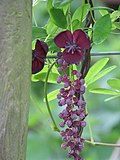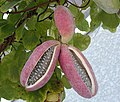Top Qs
Timeline
Chat
Perspective
Akebia
Genus of flowering plant From Wikipedia, the free encyclopedia
Remove ads
Akebia is a genus of five species of flowering plant, within the family Lardizabalaceae.
Akebia quinata is the most well known species as a minor invader in the majority of the American East Coast[2] and some states in the West Coast.[3]
Remove ads
Taxonomy
The scientific name, akebia, is a Latinization of akebi (通草), the Japanese name for the species A. quinata.[4]
Species
Remove ads
Hybrids
- Akebia × pentaphylla (Makino) Makino (A. quinata × A. trifoliata)
Fruit
Akebia quinata and Akebia trifoliata both bear edible fruit, containing a sweet white flesh.[6] Flavor varies greatly in akebias, even within the same species, with some individuals displaying a complex flavor profile resembling a mixture of banana, passionfruit and lychee, with others being mild, or even insipid (flavorless).[7] The "insipid" akebia varieties have the flavor intensity of dragon fruit[8]
Akebia in Japan
Summarize
Perspective
Akebia is often mentioned in Japanese literature, where it is evocative of pastoral settings.[9] Although the akebi commonly refers to the five-leafed species, the three-leafed species is used in much the same way for novelty food, medicine, and for vine material.
While only a minor food eaten while foraging in the past, akebia is considered a specialty crop today, only available when in season. The pods contain a white, semi-translucent gelatinous pulp that is mildly sweet and full of seeds.[10] The taste is described as sweet but rather "insipid".[10] Some people recollect in idyllic terms how they foraged for it in the hills as children.[11]
The purple-colored, slightly bitter rind has been used as a vegetable in Yamagata Prefecture[11][12] or in those northern areas, where the typical recipe calls for stuffing the rind with minced chicken (or pork) flavored with miso.[12] Minor quantities of akebia are shipped to the urban market as a novelty vegetable.
In addition to consuming the fruit, akebia leaves are also made into a tea infusion.[9] Outside of food and drinks, akebia vines are used for basket-weaving crafts. An old source lists Minakuchi, Shiga and Tsugaru (now Aomori Prefecture) as localities that produced baskets from the vines of trifoliate variety.[13]


Remove ads
Gallery
- Ripe Akebia trifoliata fruit
- Akebia quinata leaves and flowers
- Female flowers of Akebia quinata (large) and male (small)
- Early fruit of Akebia quinata
- Akebia quinata flower
- Early fruit of Akebia quinata
- Pinker more magenta fruits of an A. quinata
- Bluish variety of A. trifoliata
References
Further reading
External links
Wikiwand - on
Seamless Wikipedia browsing. On steroids.
Remove ads













